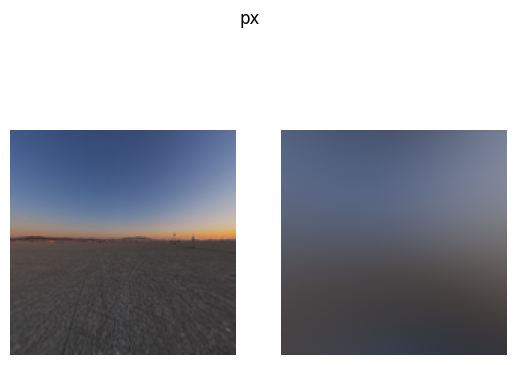【笔记】Spherical Harmonic Lighting 球谐光照再探
更新一下,使用pyshtools(或者skylib)就可以简单地完成这个工作了。
其实就是想找一个demo,从一个图片(天空盒)里整出来球谐光照,但好像没找到短小的demo
自己瞎摸索着写了一个(采样那里偷懒了,直接在cubebox上做的,这样似乎有偏,理论上应该是球上采完射回去)
自己的理解也不是很透彻,不知道对不对,效果类似这样:

主要涉及到了三个坐标系之间的转换,单位球上的球坐标,cubemap展开以后的uv坐标,合上之后的xyz坐标
然后就是采样,拟合(或者类似于反演?)出一个合适的SH光照函数,然后再射回来可视化一下
值得一提的是scipy的SH函数不是一般奇葩,参数是反着的,(1,2) (3,4) 要调换一下
然后写法也比较粗暴,速度很差
import torch
import cv2
import numpy as np
from scipy.special import sph_harm
from matplotlib import pyplot as plt
import math
def uv_2_xyz(face,u,v):
# u,v: [0,1]
uc = 2*u-1
vc = 2*v-1
x,y,z = 0,0,0
if face == 'px':
x,y,z = 1,vc,-uc
elif face == 'nx':
x,y,z = -1,vc,uc
elif face == 'py':
x,y,z = uc,1,-vc
elif face == 'ny':
x,y,z = uc,-1,vc
elif face == 'pz':
x,y,z = uc,vc,1
elif face == 'nz':
x,y,z = -uc,vc,-1
return x,y,z
def convert_xyz_to_cube_uv(x, y, z):
absX = abs(x)
absY = abs(y)
absZ = abs(z)
isXPositive = 1 if x > 0 else 0
isYPositive = 1 if y > 0 else 0
isZPositive = 1 if z > 0 else 0
if isXPositive and absX >= absY and absX >= absZ:
# u (0 to 1) goes from +z to -z
# v (0 to 1) goes from -y to +y
maxAxis = absX
uc = -z
vc = y
index = 'px'
elif not isXPositive and absX >= absY and absX >= absZ:
# u (0 to 1) goes from -z to +z
# v (0 to 1) goes from -y to +y
maxAxis = absX
uc = z
vc = y
index = 'nx'
elif isYPositive and absY >= absX and absY >= absZ:
# u (0 to 1) goes from -x to +x
# v (0 to 1) goes from +z to -z
maxAxis = absY
uc = x
vc = -z
index = 'py'
elif not isYPositive and absY >= absX and absY >= absZ:
# u (0 to 1) goes from -x to +x
# v (0 to 1) goes from -z to +z
maxAxis = absY
uc = x
vc = z
index = 'ny'
elif isZPositive and absZ >= absX and absZ >= absY:
# u (0 to 1) goes from -x to +x
# v (0 to 1) goes from -y to +y
maxAxis = absZ
uc = x
vc = y
index = 'pz'
elif not isZPositive and absZ >= absX and absZ >= absY:
# u (0 to 1) goes from +x to -x
# v (0 to 1) goes from -y to +y
maxAxis = absZ
uc = -x
vc = y
index = 'nz'
# Convert range from -1 to 1 to 0 to 1
u = 0.5 * (uc / maxAxis + 1.0)
v = 0.5 * (vc / maxAxis + 1.0)
return index, u, v
def xyz_2_theta_phi(x,y,z):
theta = np.arccos(z/np.sqrt(x**2+y**2+z**2))
phi = np.arctan2(y,x)
# theta [0,pi]
# phi [0,2pi]
if phi < 0:
phi += 2*np.pi
return theta, phi
def uniform_spherical_sample(n_samples):
"""Uniformly sample points on the surface of a sphere.
Args:
n_samples (int): number of samples to generate.
Returns:
Tensor: points on the surface of a sphere, of shape (n_samples, 2).
"""
points = torch.randn(n_samples, 3)
points = points / points.norm(dim=1, keepdim=True)
# calculate spherical coordinates
theta = torch.acos(points[:, 2])
phi = torch.atan2(points[:, 1], points[:, 0])
return torch.stack([theta, phi], dim=1) # [n_samples, 2]
def spherical_harmonics_basis(theta, phi, n_orders):
"""Compute spherical harmonics basis.
Args:
theta (Tensor): polar angle, in range [0, pi].
phi (Tensor): azimuthal angle, in range [0, 2*pi].
n_orders (int): number of orders.
Returns:
Tensor: spherical harmonics basis, of shape (n_samples, n_orders**2).
"""
# ! attention: scipy sph_harm swap (theta, phi) & (order, degree)
# compute spherical harmonics basis
basis = []
for order in range(n_orders):
for degree in range(-order, order + 1):
Ylm = sph_harm(abs(degree), order, phi, theta)
if degree < 0:
Ylm = np.sqrt(2) * (-1)**degree * Ylm.imag
elif degree > 0:
Ylm = np.sqrt(2) * (-1)**degree * Ylm.real
basis.append(Ylm.real)
basis = torch.stack(basis, dim=1) # [n_samples, n_orders**2]
return basis
cubemap = {}
for name in ['px','nx','py','ny','pz','nz']:
cubemap[name] = cv2.imread(f'data/cubemap/{name}.png')
cubemap[name] = cv2.cvtColor(cubemap[name], cv2.COLOR_BGR2RGB)
cubemap[name] = cubemap[name].astype(np.float32)/255.0
cubemap_h, cubemap_w = cubemap['px'].shape[:2]
n_samples = 100000
n_orders = 4
sample_theta_phi = []
sample_color = []
for i in range(n_samples):
sample_face = np.random.choice(['px','nx','py','ny','pz','nz'])
sample_u = np.random.uniform(0,1)
sample_v = np.random.uniform(0,1)
x,y,z = uv_2_xyz(sample_face,sample_u,sample_v)
theta, phi = xyz_2_theta_phi(x,y,z)
sample_theta_phi.append([theta,phi])
color = cubemap[sample_face][int(sample_v*cubemap_h),int(sample_u*cubemap_w)]
sample_color.append(color)
sample_theta_phi = torch.tensor(np.array(sample_theta_phi)) # [n_samples, 2]
sample_color = torch.tensor(np.array(sample_color)) # [n_samples, 3], RGB,float [0,1]
Y = spherical_harmonics_basis(sample_theta_phi[:,0],sample_theta_phi[:,1],n_orders) # [n_samples, n_orders**2]
coeffs = Y.unsqueeze(-1) * sample_color.unsqueeze(1) # [n_samples, n_orders**2, 3]
coeffs = torch.mean(coeffs,dim=0) # [n_orders**2, 3]
coeffs *= 4*np.pi # [n_orders**2, 3]
# print(coeffs)
new_cubemap = {}
for face in ['px','nx','py','ny','pz','nz']:
plt.suptitle(face)
plt.subplot(1,2,1)
plt.axis('off')
plt.imshow(cubemap[face])
new_cubemap[face] = np.zeros((cubemap_h,cubemap_w,3))
theta_list, phi_list = [],[]
for i in range(cubemap_h):
for j in range(cubemap_w):
x,y,z = uv_2_xyz(face,j/cubemap_w,i/cubemap_h)
theta, phi = xyz_2_theta_phi(x,y,z)
theta_list.append(theta)
phi_list.append(phi)
theta = torch.tensor(theta_list) # [n_samples]
phi = torch.tensor(phi_list) # [n_samples]
Y = spherical_harmonics_basis(theta,phi,n_orders) # [n_samples, n_orders**2]
tmp = torch.matmul(Y,coeffs).numpy() # [n_samples, 3]
new_cubemap[face] = tmp.reshape(cubemap_h,cubemap_w,3)
print(new_cubemap[face].min(),new_cubemap[face].max())
new_cubemap[face] = (new_cubemap[face]*255).astype(np.uint8)
plt.subplot(1,2,2)
plt.axis('off')
plt.imshow(new_cubemap[face])
new_cubemap[face] = cv2.cvtColor(new_cubemap[face], cv2.COLOR_RGB2BGR)
plt.show()
cv2.imwrite(f'data/cubemap/{face}_new.png',new_cubemap[face])
本文来自博客园,作者:GhostCai,转载请注明原文链接:https://www.cnblogs.com/ghostcai/p/17162034.html


